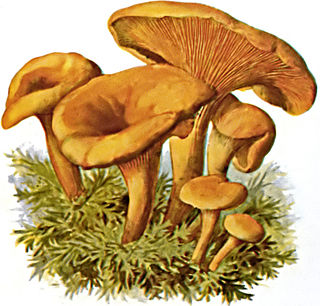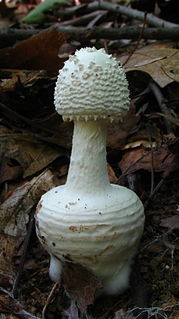In biological classification, the order is
- a taxonomic rank used in the classification of organisms and recognized by the nomenclature codes. Other well-known ranks are life, domain, kingdom, phylum, class, family, genus, and species, with order fitting in between class and family. An immediately higher rank, superorder, may be added directly above order, while suborder would be a lower rank.
- a taxonomic unit, a taxon, in that rank. In that case the plural is orders.

A truffle is the fruiting body of a subterranean ascomycete fungus, predominantly one of the many species of the genus Tuber. In addition to Tuber, many other genera of fungi are classified as truffles including Geopora, Peziza, Choiromyces, Leucangium, and over a hundred others. These genera belong to the class Pezizomycetes and the Pezizales order. Several truffle-like basidiomycetes are excluded from Pezizales, including Rhizopogon and Glomus. Truffles are ectomycorrhizal fungi, so are usually found in close association with tree roots. Spore dispersal is accomplished through fungivores, animals that eat fungi. These fungi have significant ecological roles in nutrient cycling and drought tolerance.

The Boletales are an order of Agaricomycetes containing over 1300 species with a diverse array of fruiting body types. The boletes are the best known members of this group, and until recently, the Boletales were thought to only contain boletes. The Boletales are now known to contain distinct groups of agarics, gasteromycetes, and other fruiting-body types.

A lamella, or gill, is a papery hymenophore rib under the cap of some mushroom species, most often but not always agarics. The gills are used by the mushrooms as a means of spore dispersal, and are important for species identification. The attachment of the gills to the stem is classified based on the shape of the gills when viewed from the side, while color, crowding and the shape of individual gills can also be important features. Additionally, gills can have distinctive microscopic or macroscopic features. For instance, Lactarius species typically seep latex from their gills.

Amanita cokeri, commonly known as Coker's Amanita and Solitary Lepidella, is a mushroom in the family Amanitaceae. The mushroom is poisonous. First described as Lepidella cokeri in 1928, it was transferred to the genus Amanita in 1940.

The Hygrophoropsidaceae are a family of mushrooms that are gilled in appearance but lie within the Boletales. The family contains 18 species within two genera: Leucogyrophana and Hygrophoropsis, with the best-known member being the "false chanterelle", Hygrophoropsis aurantiaca. Hygrophoropsidaceae was circumscribed by French mycologist Robert Kühner in 1980, with Hygrophoropsis as the type genus. Unlike most members of the Boletales, Hygrophoropsidaceae species are saprophytic wood-rotting fungi that cause brown rot in their hosts. The genera Austropaxillus and Tapinella, once placed in this family, are now classified in the Serpulaceae and Tapinellaceae, respectively.

Tapinella atrotomentosa, commonly known as the velvet roll-rim or velvet-footed pax, is a species of fungus in the family Tapinellaceae. Although it has gills, it is a member of the pored mushroom order Boletales. August Batsch described the species in 1783. It has been recorded from Asia, Central America, Europe and North America. Tough and inedible, it grows on tree stumps of conifers. The mushroom contains several compounds that act as deterrents of feeding by insects.

The Physalacriaceae are a family of fungi in the order Agaricales. Species in the family have a widespread distribution, ranging from the Arctic, (Rhizomarasmius), to the tropics, e.g. Gloiocephala, and from marine sites (Mycaureola) and fresh waters (Gloiocephala) to semiarid forests (Xerula).

Peniophora is a genus of fungi which are plant pathogens. Members of the genus belong to the class Agaricomycetes, order Russulales, and family Peniophoraceae. The genus is widespread, and contains 62 species. The species of Peniophora are resupinate, or crust-like, and are described as corticioid. A number of its members are parasitised by other fungi. For example, Tremella mesenterica is a parasite to several species of Peniophora.

Amanita abrupta, commonly known as the American abrupt-bulbed lepidella, is a species of fungus in the family Amanitaceae. Named for the characteristic shape of its fruit bodies, this white Amanita has a slender stem, a cap covered with conical white warts, and an "abruptly enlarged" swollen base. This terrestrial species grows in mixed woods in eastern North America and eastern Asia, where it is thought to exist in a mycorrhizal relationship with a variety of both coniferous and deciduous tree species.

Spongipellis is a genus of fungi in the family Polyporaceae. The genus is widely distributed and contains ten species. The genus was circumscribed by French mycologist Narcisse Théophile Patouillard in 1887. The genus name combines the Latin words spongia ("sponge") and pellis ("skin").

Amanita regalis, commonly known as the royal fly agaric or the king of Sweden Amanita, is a species of fungus in the family Amanitaceae. Common in Scandinavian countries, it is also found in eastern and northern Europe. In North America, its distribution is restricted to Alaska. The fruit bodies of the fungus somewhat resemble the fly agaric, and it was formerly regarded as a variety of this species. A. regalis differs from it in being larger, with a liver-brown cap bearing numerous scabs, and in having a stem which is yellow-ochre at the base, with patches or rings of patches. Chemical analysis has shown that this species contains muscimol, the same psychoactive compound found in A. muscaria.

Amanita rubrovolvata, commonly known as the red volva Amanita, is a species of fungus in the family Amanitaceae. First described scientifically by the Japanese mycologist S. Imai in 1939, it is widely distributed in eastern Asia. The fungus produces small to medium-sized mushrooms, with reddish-orange caps up to 6.5 mm (0.26 in) wide. The stems are up to 100 mm (3.9 in) tall, cream above the ring and cream to yellowish below it. The stem ends in a roughly spherical bulb at the base, which is covered with bright orange patches. Neither edibility nor toxicity have been established for the fungus, but it is suspected to be associated with neurological anomalies. Several molecular studies have confirmed the mushroom's classification in the subgenus Amanita of the genus Amanita, along with closely related species such as A. muscaria.
Boletellus jalapensis is a species of fungus in the family Boletaceae. Originally described under the name Ceriomyces jalapensis by William Alphonso Murrill in 1910, it was transferred to the genus Boletellus in 1931. It is known from Mexico and Costa Rica.

Atromentin is a natural chemical compound found in Agaricomycetes fungi in the orders Agaricales and Thelephorales. It can also be prepared by laboratory synthesis. Chemically, it is a polyphenol and a benzoquinone.

Saproamanita nauseosa is a species of agaric fungus in the family Amanitaceae. First described by English mycologist Elsie Maud Wakefield in 1918 as a species of Lepiota, it was named for its nauseating odor. The type specimen was found growing on soil in the Nepenthes greenhouse at Kew Gardens. Derek Reid transferred the species to Amanita in 1966, and then in 2016 the separate genus Saproamanita was created by Redhead et al. for saprophytic Amanitas and it was transferred to this new genus.

Imleria badia, commonly known as the bay bolete, is an edible, pored mushroom found in Europe and North America, where it grows in coniferous or mixed woods on the ground or on decaying tree stumps, sometimes in prolific numbers. Both the common and scientific names refer to the bay- or chestnut-coloured cap, which is almost spherical in young specimens before broadening and flattening out to a diameter up to 15 cm (6 in). On the cap underside are small yellowish pores that turn dull blue-grey when bruised. The smooth, cylindrical stipe, measuring 4–9 cm (1.6–3.5 in) long by 1–2 cm (0.4–0.8 in) thick, is coloured like the cap, but paler. Some varieties have been described from eastern North America, differing from the main type in both macroscopic and microscopic morphology.















